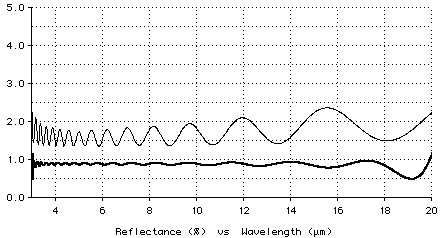Broadband Antireflection Graded-Index Coating
-
Peter H. Berning, "Use of Equivalent films in the design of infrared multilayer antireflection
coatings", Journal of the Optical Society of America, Vol. 52(4), pp. 431-436 (April 1962).
one of the coatings discussed by the author is a step-graded-index antireflection coating for germanium. This coating consists of 20 quarter-wave layers whose indices vary linearly from 1.35 (the lowest practical index available) to 4 (the index of germanium), as illustrated below.



Here is the list of refractive indices in the optimized design, starting with the layer
closest to the germanium substrate:
1 3.9356
2 3.7482
3 3.3986
4 2.9121
5 2.3790
6 1.9044
7 1.5598
8 1.3726
9 1.3500
10 1.5042
11 1.8606
12 2.4315
13 3.1456
14 3.7738
15 4.0000
16 3.6871
17 3.0181
18 2.3016
19 1.7310
20 1.3500
The reference wavelength for the quarter-wave optical thickness is 5.217 microns,
which is the midpoint, in the frequency scale, between 3 and 20 microns.
Note: by using more layers, designs with more cycles of the sine curve can be found. However, the additional cycles do not improve the performance as dramatically as above.
Download Design
You may download the Berning design and watch how TFCalc optimizes it. You will need a real copy (i.e., not a demo) of TFCalc. Click here for the Windows or Macintosh file. This design assumes that you have a substrate called G whose index is 4. The G substrate was installed with the TFCalc software.Windows users, when they download this file, will have to save it to disk. Be sure to save it with extension ".TFD".